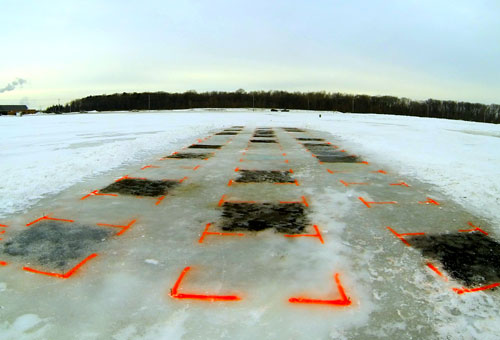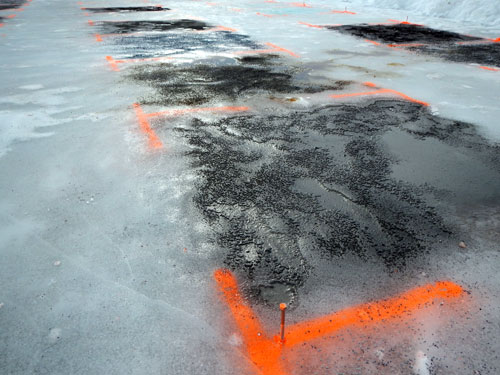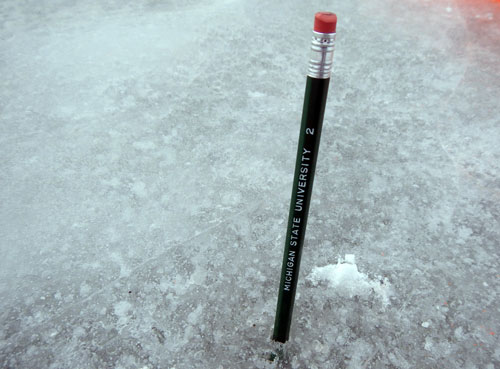Melting ice sheets on putting greens
Different products can be used to facilitate melting ice sheets on putting greens.
When given lemons, make lemonade. When given an ice sheet, conduct an ice melt study. On Jan. 31, 2014, at the Michigan State University Hancock Turfgrass Research Center (HTRC), Michigan State University Extension specialists conducted an ice melting study in cooperation with Andrew Hollman, Brian Horgan and Sam Bauer from the University of Minnesota. We tested 20 products for their ability to melt ice. Conditions during our treatment window, which began at approximately 11 a.m. and concluded at 5:30 p.m., had temperatures hovering around 25 degrees Fahrenheit and constant cloud cover. The treatments can be broken down into three general categories:
Standard chemcials/salts (all application rates 28 pounds per 1,000 square feet)
1. Calcium chloride
2. Sodium chloride
3. Potassium chloride
4. Magnesium chloride
“Safer” ice melt products (all application rates 28 pounds per 1,000 square feet)
5. Calcium magnesium acetate (CMA)
6. Sodium acetate (NAAC)
7. Enviro Melt (carbonyl diamide/urea)
8. Safe Paws (modified amide/glycol admixture)
9. Paw Thaw (CMA and fertilizer)
10. Tenderfoot Ice Melter (urea and DeFrost)
11. Ammonium sulfate
Solar absorption products (dark colored)
12. Milorganite greens grade (56 pounds per 1,000 square feet)
13. Sustane greens grade (40 pounds per 1,000 square feet)
14. Top Cut biosolids SGN 90 (53 pounds per 1,000 square feet)
15. Top Cut SGN 200 (53 pounds per 1,000 square feet)
16. Top Cut + DeFrost SGN 200 (53 pounds per 1,000 square feet)
17. BioDac + DeFrost SGN 200 (47 pounds per 1,000 square feet)
18. BioDac + DeFrost + Colorant SGN200 (47 pounds per 1,000 square feet)
19. Eon 75 humic acid (47 pounds per 1,000 square feet)
20. Black sand (100 pounds per 1,000 square feet)

Treatments on ice sheet at MSU. Photo credit: Kevin Frank, MSU
We recorded surface ice temperatures prior to treatment application and at intervals following applications using an infrared temperature sensor. We rated ice melt based on observation of standing water on the plots on a scale from 1-5 with 1 = no visible melt and 5 = visible standing water.
Surface temperatures prior to treatment application were very similar to air temperatures 25-26 F. One hour after treatment application, the treatments were separated into two groups, the standard salts and safer ice melt products versus the solar absorption products. The solar absorption products with their dark coloration had surface ice temperatures of 35-37 F whereas the salts and safer treatments had surface ice temperatures of 27-31 F. Treatments were still significantly different at 4.5 hours after treatment application, although the temperatures for the solar absorption products declined to 30-32 F, most likely due to the sun setting.
There were also differences in visible melt from the treatments. The following treatments produced the most visible melt:
- Milorganite, Sustane
- Top Cut biosolids SGN 90
- Eon 75 humic acid
- Black sand
The standard salts and safer ice melt treatments produced very little visible ice melt.

Solar absorption products had the greatest melting. Photo credit: Kevin Frank, MSU
The standard salts were the only treatments we observed that were able to penetrate through the 2-inch ice sheet so they could be effective in facilitating gas exchange with the surface, but of course there is the risk of turf burning from the salt properties of these treatments.

Calcium chloride melted holes all the way to the turf surface. Photo credit: Kevin Frank, MSU
Overall, even though temperatures were below freezing and cloud cover persisted, the solar absorption treatments were effective at melting the ice surface, but were unable to melt to the surface given our 2-inch ice sheet. We are planning to replicate this trial again this coming week (as of Feb. 14, 2014) at both MSU and Minnesota when temperatures are forecast to be above freezing. We will also be assessing turfgrass phytotoxicity from the treatments this spring.
Helping the melt
Next week, most areas of Michigan are forecast to have temperatures above freezing and possibly into the mid-40s in combination with rain. Many superintendents have been attempting to clear greens down to the ice layer to facilitate melting. Keep in mind that if this melt occurs there is going to be a tremendous amount of water that will be moving off greens.
Ensuring the water can exit the greens will be critical to try and prevent water backing up onto the green and refreezing if temperatures drop below freezing at night. Ultimately, Mother Nature is going to dictate whether or not our Poa annua putting greens have survived the ice sheet and the pending melting and freezing in the next month.
Dr. Frank's work is funded in part by MSU's AgBioResearch.



 Print
Print Email
Email



